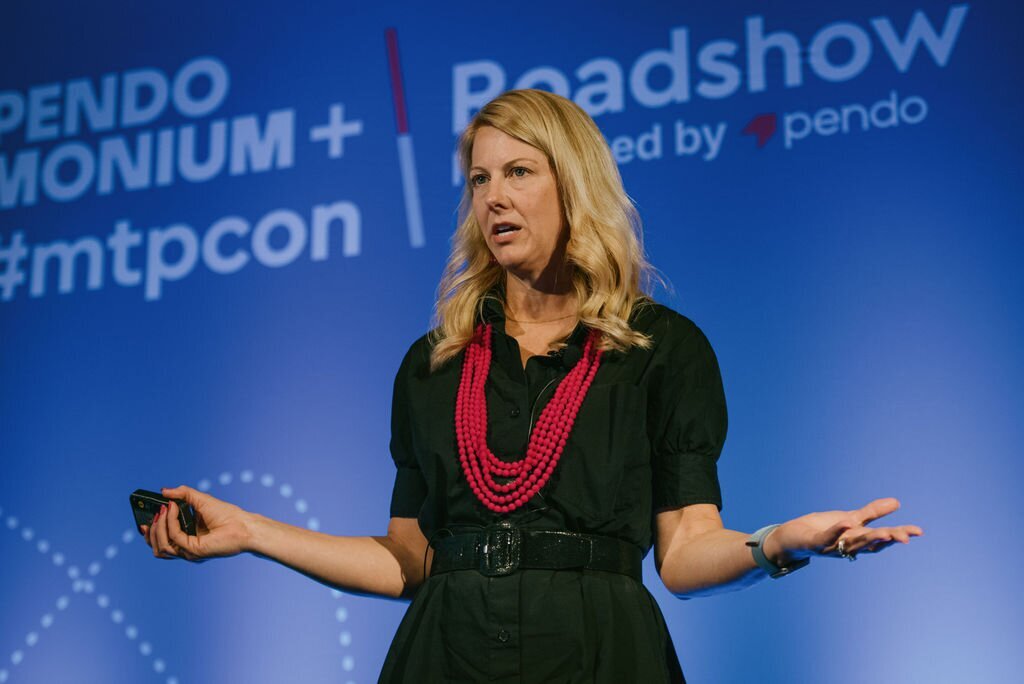We just wrapped up our Pendomonium + #mtpcon 2024 roadshow across Amsterdam, London, and Berlin–during which Pendo SVP of Product Management & User Experience Nichole Mace spoke about Pendo’s vision for the future of product management and AI’s role in that evolution.
Key takeaways
- Pay close attention to the shifts in consumer expectations and be ready to adapt quickly
- Leverage AI to make your processes more efficient and improve customer experiences
- Prioritize speed and agility when thinking about your AI options: to build, buy, or partner
When Nichole led the product team at Zipcar in 2015, no one at the company suspected a ride-share company like Uber would throw the company for a loop. Within 18 months, Uber completely changed how people felt about having a car. They no longer wanted access to a vehicle they had to drive, park, and leave for hours. She reflects on how no one at Zipcar saw the disruption coming, and how unexpected change continues to happen.
“Nine years later, the world is changing dramatically right before my eyes,” she says.
How can you build a roadmap and reinvent at the exact same time?
Fast forward to 2023, Mace talks about how the Pendo product growth team realized the need to make a complete shift from their original roadmap.
When things start to change, you can’t sit by and watch the world move while sitting still.
— Nichole Mace
She likens this time of rapid change and growth to the dot-com era, with new companies being created every day and established companies reinventing themselves. A similar era of change is happening now with AI.
She describes how Y Combinator had 86 AI startups in 2023, which is double what they had the year before. She points out that we’re living in a time of explosion where AI companies aren’t just “ankle biters.” They’re disruptors that will push all of us to do better.
Significant changes and challenges for product managers
Mace acknowledges that embracing disruption is just one (albeit significant) part of the product team’s job. It can be exhausting and challenging for product managers to stay ahead while still excelling in their day-to-day responsibilities. She points out the areas that product managers are expected to manage consistently: from reducing churn and moving upmarket, to reducing tech debt and expanding globally.
While product managers are masters of prioritizing and pivoting, dramatic change is coming, says Mace. A few examples she shared for how AI is dramatically changing the field of product management:
- Synthesizing customer feedback
- Automatically triaging feedback
- Writing PM summaries
- Creating roadmaps that are collaborative and flexible
The tools we can now leverage today will help product managers become more efficient and effective with their impact on business outcomes.
Leverage AI to drive value through insights and personalization
Using AI is helpful when it comes to being more efficient with product development, Mace says. And it’s equally helpful to drive more value for customers. At Pendo, Mace talks about how the company’s usage of AI has evolved over time.
“We started solving customer pain with product discovery,” she says. “Two years ago, we started with Topics, then Insights, and now we’re launching an entire product to enable faster and more confident product discovery. Then ChatGPT came out, and we could accelerate our timeline with Pendo Listen.”
She emphasizes that while gathering information is a major part of a product manager’s job, it often becomes unmanageable. Tools that streamline this process, especially those like Pendo Listen that utilize AI for insights and summaries, are invaluable for product managers as they speed up the time to insight.
4 ways to prioritize speed and agility in the age of AI
As product managers begin to embrace new technologies and reevaluate their processes, increasing speed will become a priority. If one thing in product management is inevitable, Mace says, it will be the need to speed up. She wraps up her presentation with a final few pieces of advice for tomorrow’s product managers.
Try out new tools
Even if you don’t want to use them, they will improve you and your team’s perspective. Mace highlights the wide variety of tools available and how easy they are to try. You might just discover your new favorite productivity helper.
Get feedback early
Early feedback helps with prioritization. Mace advises establishing an iterative release cadence that incorporates continuous feedback so teams can get near real-time customer insights to inform the next wave of releases.
Timebox select projects to stay ahead
Timeboxing places a strict time frame around a project which helps prioritize initiatives and simplify the end product. For timeboxing to work, teams need a committed leader, an aggressive but realistic timeline, and an empowered team. Mace points out that Google AdSense was a timeboxed initiative completed within a three-month deadline.
Stay curious
Mace wraps up her session by challenging the audience to stay curious — about our processes, workflows, and the tools we use. Try new things (like timeboxing) and embrace the inevitable changes.
More recaps from the Pendomonium + #mtpcon 2024 roadshow
- 6 things we learned at the Pendomonium + #mtpcon roadshow — London 2024
- 5 tips from the Pendomonium + #mtpcon roadshow — Amsterdam 2024





